 |
A thought as we ponder the many meanings of 9/11 - our greatest luxury is taking freedom for granted. While American artists are hardly immune from political pressure over access, funding and indecency, their frustration is a far cry from the repression of other times and places, when straying from official dictates destroyed careers and even lives. our greatest luxury is taking freedom for granted. While American artists are hardly immune from political pressure over access, funding and indecency, their frustration is a far cry from the repression of other times and places, when straying from official dictates destroyed careers and even lives.
The Fifth Symphony of Dmitri Shostakovich (1906 - 1975) memorializes the intense politics that surrounded its creation and the clash between stifling ideology and irrepressible creative impulse that has colored its interpretation. memorializes the intense politics that surrounded its creation and the clash between stifling ideology and irrepressible creative impulse that has colored its interpretation.
Shostakovich's brilliance and originality emerged in his very first symphony, written at age 19 as a graduation exercise from the Leningrad music conservatory. A remarkable work by any standards, its youthful drive and bold orchestration is balanced by ardent reflection and sardonic wit, signaling a burgeoning force of prodigious, daring and wide-ranging talent.  But Shostakovich was the first great composer to mature under Communism, and ideology smothered his second and third symphonies, both of which, despite impressive quiet moments and suggestions of striking developments, devolve into drab descriptive choral endings commemorating the October Revolution and May Day. Yet, modernist tendencies erupted in his 1933 opera Lady Macbeth of Mzensk, a violent and erotic tale of murder and depravity depicted through suitably frank musical effects (including trombone glissandos during lovemaking). In the wake of its sensational success both abroad and at home, Shostakovich was widely acclaimed as Russia's greatest living composer and his fortune appeared secure. But Shostakovich was the first great composer to mature under Communism, and ideology smothered his second and third symphonies, both of which, despite impressive quiet moments and suggestions of striking developments, devolve into drab descriptive choral endings commemorating the October Revolution and May Day. Yet, modernist tendencies erupted in his 1933 opera Lady Macbeth of Mzensk, a violent and erotic tale of murder and depravity depicted through suitably frank musical effects (including trombone glissandos during lovemaking). In the wake of its sensational success both abroad and at home, Shostakovich was widely acclaimed as Russia's greatest living composer and his fortune appeared secure.
But then in January 1936 Joseph Stalin attended a performance of the opera and was appalled. According to Stalin, music had to inspire and unite the Soviet people with uplifting messages. His taste was simplistic, but his power absolute. 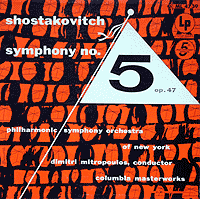 The Pravda party newspaper immediately branded Shostakovich an enemy of the people and condemned his work as chaotic, vulgar and perverted. The episode launched a full-fledged general attack on modern art as bourgeois formalism (whatever that was supposed to mean) and left-wing degeneracy. Shostakovich was the bulls-eye. The abrupt reversal of official attitude took Shostakovich completely by surprise and plunged him into deep despair. He was snubbed, performances of his works were cancelled and his career seemed over. Yet, he soon found a constructive cure for his pain. The Pravda party newspaper immediately branded Shostakovich an enemy of the people and condemned his work as chaotic, vulgar and perverted. The episode launched a full-fledged general attack on modern art as bourgeois formalism (whatever that was supposed to mean) and left-wing degeneracy. Shostakovich was the bulls-eye. The abrupt reversal of official attitude took Shostakovich completely by surprise and plunged him into deep despair. He was snubbed, performances of his works were cancelled and his career seemed over. Yet, he soon found a constructive cure for his pain.
Shostakovich was in the midst of rehearsing his Mahleresque Fourth Symphony, but immediately withdrew it, and with good reason. When finally performed in 1961, it emerged as long, bittersweet, atmospheric and crammed with ideas - fine, forward-looking stuff, but destined at the time to be more fodder for Stalin's cultural cannon. Instead, he plunged into work on a new, more traditional symphony. There would be no mistaking its purpose. Shostakovich titled it “An Artist's Creative Response to Just Criticism” and announced its program as “the stabilization of a personality of a man with all his experiences.” He proclaimed: “There can be no greater joy for a composer than ... having assisted by his works in the elevation of Soviet musical culture ... to contribute to the growth of our country.”  When presented in celebration of the 20th anniversary of the Revolution, it was acclaimed a masterpiece, embracing the soul of the Russian people. Shostakovich would again fall out of favor - trying to vaunt an image of progress and unity, Khruschev didn't appreciate the 1962 Symphony # 13 which evoked the Jewish massacre at Babi Yar. But for now his redemption was complete. When presented in celebration of the 20th anniversary of the Revolution, it was acclaimed a masterpiece, embracing the soul of the Russian people. Shostakovich would again fall out of favor - trying to vaunt an image of progress and unity, Khruschev didn't appreciate the 1962 Symphony # 13 which evoked the Jewish massacre at Babi Yar. But for now his redemption was complete.
From that point forward, most of Shostakovich's music took two divergent paths. His public music (symphonies, ballets, concertos) mostly retreated to the safety of ideologically-correct programs and crowd-pleasing music. Only in more private works, especially his magnificent quartets, did boldly inventive personality enliven his forms and ideas. This duality, together with the unevenness of his output, led to the notion of a promising artist crushed by the boorish Communist regime, a paradigm which held potent symbolic appeal to the West in the throes of the Cold War. Thus, the 1947 American Concert Companion called Shostakovich “an active cog in the Soviet machine,” unable to extract himself from the straitjacket of party dogma. The exhaustive 8,000-page 1954 British Grove's Dictionary of Music and Musicians dismissed him in a brief note as being forced into insignificance through a trite and cheap style of deliberate calculations and conventional simplicity. Shostakovich had become a compelling and convenient paradigm for propaganda.
But attempts to categorize artists as one-dimensional souls often fail and, indeed, there's another side to Shostakovich. Late in his career,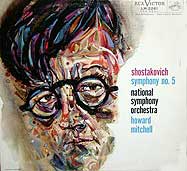 the composer left a bitter memoir in which he viewed his life as one of vast regret that repression had destroyed his urge toward creative expression. Those who knew him well agreed that he was deeply unhappy. They further claimed that his outward capitulation was a mere ploy and that he had survived as an artist of integrity by sneaking hidden agendas into his music while paying lip service to the demands of the authorities. In a 1981 US News and World Report interview, his son Maxim decried as defamation the Soviet depiction of his father as an ardent Communist, insisted that he hated Stalin and had joined the Party only under threat of blackmail, and called his music “a profound expression of protest against the circumstances in which he found himself.” As for the Fifth Symphony, the composer had publicly announced the finale as “resolving the tragically tense impulses of the earlier movements into optimism and the joy of living.” Looking back in times of d�tente, though, he claimed that the end was deliberately strained, a false optimism created under a threat, which he likened to sadistic torture of being forced to smile while being beaten: “You have to be a complete oaf not to hear that.” the composer left a bitter memoir in which he viewed his life as one of vast regret that repression had destroyed his urge toward creative expression. Those who knew him well agreed that he was deeply unhappy. They further claimed that his outward capitulation was a mere ploy and that he had survived as an artist of integrity by sneaking hidden agendas into his music while paying lip service to the demands of the authorities. In a 1981 US News and World Report interview, his son Maxim decried as defamation the Soviet depiction of his father as an ardent Communist, insisted that he hated Stalin and had joined the Party only under threat of blackmail, and called his music “a profound expression of protest against the circumstances in which he found himself.” As for the Fifth Symphony, the composer had publicly announced the finale as “resolving the tragically tense impulses of the earlier movements into optimism and the joy of living.” Looking back in times of d�tente, though, he claimed that the end was deliberately strained, a false optimism created under a threat, which he likened to sadistic torture of being forced to smile while being beaten: “You have to be a complete oaf not to hear that.”
Orchestral music is inherently abstract and thus amenable to diverse narrative interpretations. The first three movements of the Fifth can be viewed consistent with the composer's official program as depictions of his artistic “mistakes ”and soul-searching, a catalogue of evil to render his ultimate salvation all the more convincing. The first movement is constructed in a long, continuous arc, mounting from a brooding opening through a central climax of a shrill, minor-key, mock-militaristic march which then withers into fatigued contemplation. 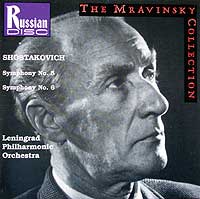 Next comes a lumpy, clumsy waltz and then a magnificent Largo, another long arc but this time of a bittersweet, aching intensity that pointedly contrasts with intentional shallowness of the preceding material. While the heartfelt Largo is the work's emotional core, it's the finale that carries the narrative weight, beginning in exhausting aggression, subsiding into penetrating reflection and concluding with a sustained repetitious march. In most European or American interpretations, the end is stirring and triumphant, a confident and decisive victory over doubt, fully consistent with the composer's written program and the brisk tempo marking in the published score (188 beats per minute). In all Russian versions, though, it tends to be agonizingly slow - grueling, heavy, labored and grim, pounding away at a single repeated chord with far more desperation than joy. Which approach is apt? Next comes a lumpy, clumsy waltz and then a magnificent Largo, another long arc but this time of a bittersweet, aching intensity that pointedly contrasts with intentional shallowness of the preceding material. While the heartfelt Largo is the work's emotional core, it's the finale that carries the narrative weight, beginning in exhausting aggression, subsiding into penetrating reflection and concluding with a sustained repetitious march. In most European or American interpretations, the end is stirring and triumphant, a confident and decisive victory over doubt, fully consistent with the composer's written program and the brisk tempo marking in the published score (188 beats per minute). In all Russian versions, though, it tends to be agonizingly slow - grueling, heavy, labored and grim, pounding away at a single repeated chord with far more desperation than joy. Which approach is apt?
Although he made some piano records, Shostakovich never conducted his symphonies before the microphone. Fortunately, we have over a dozen recordings of his Fifth by Yevgeny Mravinsky, an unknown rising conductor whom the composer chose to lead the world premiere and who became his foremost disciple. Their shared success on that occasion not only restored Shostakovich to favor but launched Mravinksy's half-century career as the permanent director of the Leningrad Philharmonic, Russia's foremost orchestra. 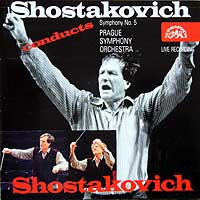 For the rest of their lives, the two remained close associates - Mravinsky introduced most of Shostakovich's further symphonies, while the composer extolled the conductor's dour demeanor and somber approach as fully realizing his intentions. Months after their premiere of the Fifth, Mravinsky and the Leningrad Philharmonic cut a set of 78s which never appeared on LP or CD, but they returned to the studio in 1954 for a magnificent remake (now on BMG/Melodiya CD 29404), straightforward and focused, yet sharp and caustic, that culminates in that oppressively lumbering finale. Numerous Mravinsky/Leningrad concert tapings (on Russian Disc and other labels) present subtle variations of the same fundamental interpretation. For the rest of their lives, the two remained close associates - Mravinsky introduced most of Shostakovich's further symphonies, while the composer extolled the conductor's dour demeanor and somber approach as fully realizing his intentions. Months after their premiere of the Fifth, Mravinsky and the Leningrad Philharmonic cut a set of 78s which never appeared on LP or CD, but they returned to the studio in 1954 for a magnificent remake (now on BMG/Melodiya CD 29404), straightforward and focused, yet sharp and caustic, that culminates in that oppressively lumbering finale. Numerous Mravinsky/Leningrad concert tapings (on Russian Disc and other labels) present subtle variations of the same fundamental interpretation.
In his prestigious position, Mravinsky was bound to respect official expectations, and undoubtedly tempered his readings accordingly. A yet stronger claimant to authenticity was even closer to the composer - his son Maxim, who made a career of leading his father's work. Of his three recordings of the Fifth, the most revealing is the last - a beautifully played and recorded 1996 Czech concert (Supraphon 3327) that's also the slowest on record, with the conclusion so deadly turgid as to leave no possible doubt as to its import. 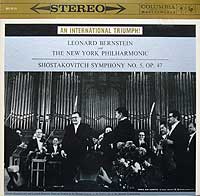 Was his son's final reading how the composer really wanted his work to sound? My guess is that it was. Not only does Maxim's lineage suggest unique insight, but he had defected to the West and was free of expressive constraints. Was his son's final reading how the composer really wanted his work to sound? My guess is that it was. Not only does Maxim's lineage suggest unique insight, but he had defected to the West and was free of expressive constraints.
Perhaps the most curious episode in the history of Russian performance of this work occurred in 1958. In a goodwill gesture marking an early thaw in the Cold War, Leonard Bernstein and the New York Philharmonic included several Russian stops during their first European concert tour. The programs boldly featured unfamiliar American and modern music, but their most daring gesture was to include the Shostakovich Fifth. Typically, Bernstein played the work with searing emotional heat and whipped up the conclusion to twice the accepted tempo. 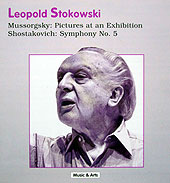 He was recalled for dozens of curtain calls and official critics hailed the depth of feeling, dramatic intensity and especially the dynamism of the finale. The irony, of course, is that the acclaim arose from an audience of Party loyalists to whom the young American's approach validated the composer's proclaimed intent of vaunting Socialist Realism far more forcefully than the shrewdly dissident domestic interpretations to which they were accustomed. Upon returning home, Bernstein and the Philharmonic recorded their triumph for Columbia. Vibrant, sharp and pulsing with vitality, it remains a remarkable document (Sony 47615). He was recalled for dozens of curtain calls and official critics hailed the depth of feeling, dramatic intensity and especially the dynamism of the finale. The irony, of course, is that the acclaim arose from an audience of Party loyalists to whom the young American's approach validated the composer's proclaimed intent of vaunting Socialist Realism far more forcefully than the shrewdly dissident domestic interpretations to which they were accustomed. Upon returning home, Bernstein and the Philharmonic recorded their triumph for Columbia. Vibrant, sharp and pulsing with vitality, it remains a remarkable document (Sony 47615).
In part, the Russian fervor for Bernstein arose from their isolation and resultant ignorance of a parallel interpretive custom as venerable as their own. In the same year as Mravinsky's premiere recording, Leopold Stokowski and the Philadelphia Orchestra had launched a tradition of playing the Fifth with overt fervor (Pearl 9064). 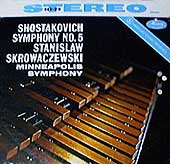 That tradition was extended through superbly muscular mid-'fifties recordings by Dimitri Mitropoulos and the New York Philharmonic (Columbia) and Artur Rodzinski and the Philharmonic Symphony of London (Westminster), the latter a remake of Rodzinski's 1941 78s with the Cleveland Orchestra, which featured the fastest (albeit slightly cut) conclusion of all (Lys CD 139). But fittingly, it was Stokowski again, at a youthful 82, who ignited the work to its whitest heat in a spectacular 1964 London Symphony concert (Music and Arts 765). That tradition was extended through superbly muscular mid-'fifties recordings by Dimitri Mitropoulos and the New York Philharmonic (Columbia) and Artur Rodzinski and the Philharmonic Symphony of London (Westminster), the latter a remake of Rodzinski's 1941 78s with the Cleveland Orchestra, which featured the fastest (albeit slightly cut) conclusion of all (Lys CD 139). But fittingly, it was Stokowski again, at a youthful 82, who ignited the work to its whitest heat in a spectacular 1964 London Symphony concert (Music and Arts 765).
The irony of the acclaim for the Bernstein tour still resonates to skew critical opinion, which generally ignores or scorns recordings that lack the charismatic energy of the more overtly striking ones.  Yet, perhaps these "uninspired" conductors deliberately bypassed the superficial appeal of electrifying the score with a dynamic interpretation, and had the true measure of the work after all. Among these are the stolid inertia of Bernard Haitink and the Concertgebouw (London 410017), the arid expanse of Sergiu Celibidache and the Milan RAI (Arkadia 765), and especially the edgy nervous imbalance of Stanislaw Skrowaczewski and the Minneapolis Symphony (Mercury 434 232). Yet, perhaps these "uninspired" conductors deliberately bypassed the superficial appeal of electrifying the score with a dynamic interpretation, and had the true measure of the work after all. Among these are the stolid inertia of Bernard Haitink and the Concertgebouw (London 410017), the arid expanse of Sergiu Celibidache and the Milan RAI (Arkadia 765), and especially the edgy nervous imbalance of Stanislaw Skrowaczewski and the Minneapolis Symphony (Mercury 434 232).
So - was Shostakovich a Party pawn or a subtle subversive? Perhaps he and his compatriots had the last say by embedding a sly but potent message in the finale of his Fifth Symphony for those willing to discern it - aesthetically numb and ignorant ideologues (and unsuspecting Western musicians) could believe his submissive words and find a trove of excited triumph, but anyone with receptive ears, a responsive heart and a sensitive soul would grasp his torment and despair for his country's trampled but enduring spirit.

Copyright 2002 by Peter Gutmann
|
